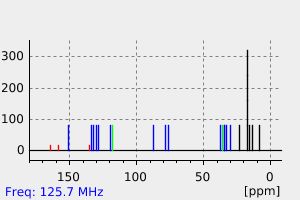6,7-seco-Discodermolide
中文名称
——
中文别名
——
英文名称
6,7-seco-Discodermolide
英文别名
[(3Z,5S,6S,7S,8R,9S,11Z,13S)-8-hydroxy-5,7,9,11-tetramethyl-13-[(2S,3S)-3-methyl-6-oxo-2,3-dihydropyran-2-yl]tetradeca-1,3,11-trien-6-yl] carbamate
CAS
——
化学式
C25H39NO5
mdl
——
分子量
433.588
InChiKey
IWHUTUDZNNKLLU-OPRQYEGWSA-N
BEILSTEIN
——
EINECS
——
-
物化性质
-
计算性质
-
ADMET
-
安全信息
-
SDS
-
制备方法与用途
-
上下游信息
-
文献信息
-
表征谱图
-
同类化合物
-
相关功能分类
-
相关结构分类
计算性质
-
辛醇/水分配系数(LogP):5.7
-
重原子数:31
-
可旋转键数:12
-
环数:1.0
-
sp3杂化的碳原子比例:0.6
-
拓扑面积:98.8
-
氢给体数:2
-
氢受体数:5
上下游信息
-
上游原料
中文名称 英文名称 CAS号 化学式 分子量 盘皮海绵内酯 discodermolide 127943-53-7 C33H55NO8 593.802
反应信息
-
作为反应物:描述:6,7-seco-Discodermolide 在 titanium(IV) isopropylate 作用下, 以 二氯甲烷 为溶剂, 反应 336000.0h, 以0.6 mg的产率得到(2S,3S)-2-[(2S,3Z,6S,7R,8S,9S,10S,11Z)-7,9-dihydroxy-4,6,8,10-tetramethyltetradeca-3,11,13-trien-2-yl]-3-methyl-2,3-dihydropyran-6-one参考文献:名称:Semisynthetic Analogues of the Microtubule-Stabilizing Agent Discodermolide: Preparation and Biological Activity摘要:A series of 12 semisynthetic discodermolide analogues, 2-13, have been prepared using natural (+)discodermolide (1) and evaluated for in vitro cytotoxicity against cultured murine P-388 leukemia and A-549 human adenocarcinoma cells. These semisynthetic analogues showed a significant variation of cytotoxicity and confirmed the importance of the C-7 through C-19 molecular fragment for potency. Specifically, these analogues suggested the importance of the C-11 and C-17 hydroxyl groups and the C-13 double bond for the potency of discodermolide. The preparation, structure elucidation, and biological activity of these new analogues are described.DOI:10.1021/np0203234
-
作为产物:描述:参考文献:名称:Semisynthetic Analogues of the Microtubule-Stabilizing Agent Discodermolide: Preparation and Biological Activity摘要:A series of 12 semisynthetic discodermolide analogues, 2-13, have been prepared using natural (+)discodermolide (1) and evaluated for in vitro cytotoxicity against cultured murine P-388 leukemia and A-549 human adenocarcinoma cells. These semisynthetic analogues showed a significant variation of cytotoxicity and confirmed the importance of the C-7 through C-19 molecular fragment for potency. Specifically, these analogues suggested the importance of the C-11 and C-17 hydroxyl groups and the C-13 double bond for the potency of discodermolide. The preparation, structure elucidation, and biological activity of these new analogues are described.DOI:10.1021/np0203234
表征谱图
-
氢谱1HNMR
-
质谱MS
-
碳谱13CNMR
-
红外IR
-
拉曼Raman
-
峰位数据
-
峰位匹配
-
表征信息
同类化合物
(5β,6α,8α,10α,13α)-6-羟基-15-氧代黄-9(11),16-二烯-18-油酸
(3S,3aR,8aR)-3,8a-二羟基-5-异丙基-3,8-二甲基-2,3,3a,4,5,8a-六氢-1H-天青-6-酮
(2Z)-2-(羟甲基)丁-2-烯酸乙酯
(2S,4aR,6aR,7R,9S,10aS,10bR)-甲基9-(苯甲酰氧基)-2-(呋喃-3-基)-十二烷基-6a,10b-二甲基-4,10-dioxo-1H-苯并[f]异亚甲基-7-羧酸盐
(1aR,4E,7aS,8R,10aS,10bS)-8-[((二甲基氨基)甲基]-2,3,6,7,7a,8,10a,10b-八氢-1a,5-二甲基-氧杂壬酸[9,10]环癸[1,2-b]呋喃-9(1aH)-酮
(+)顺式,反式-脱落酸-d6
龙舌兰皂苷乙酯
龙脑香醇酮
龙脑烯醛
龙脑7-O-[Β-D-呋喃芹菜糖基-(1→6)]-Β-D-吡喃葡萄糖苷
龙牙楤木皂甙VII
龙吉甙元
齿孔醇
齐墩果醛
齐墩果酸苄酯
齐墩果酸甲酯
齐墩果酸溴乙酯
齐墩果酸二甲胺基乙酯
齐墩果酸乙酯
齐墩果酸3-O-alpha-L-吡喃鼠李糖基(1-3)-beta-D-吡喃木糖基(1-3)-alpha-L-吡喃鼠李糖基(1-2)-alpha-L-阿拉伯糖吡喃糖苷
齐墩果酸 beta-D-葡萄糖酯
齐墩果酸 beta-D-吡喃葡萄糖基酯
齐墩果酸 3-乙酸酯
齐墩果酸 3-O-beta-D-葡吡喃糖基 (1→2)-alpha-L-吡喃阿拉伯糖苷
齐墩果酸
齐墩果-12-烯-3b,6b-二醇
齐墩果-12-烯-3,24-二醇
齐墩果-12-烯-3,21,23-三醇,(3b,4b,21a)-(9CI)
齐墩果-12-烯-3,21,23-三醇,(3b,4b,21a)-(9CI)
齐墩果-12-烯-3,11-二酮
齐墩果-12-烯-2α,3β,28-三醇
齐墩果-12-烯-29-酸,3,22-二羟基-11-羰基-,g-内酯,(3b,20b,22b)-
齐墩果-12-烯-28-酸,3-[(6-脱氧-4-O-b-D-吡喃木糖基-a-L-吡喃鼠李糖基)氧代]-,(3b)-(9CI)
齐墩果-12-烯-28-酸,3,7-二羰基-(9CI)
齐墩果-12-烯-28-酸,3,21,29-三羟基-,g-内酯,(3b,20b,21b)-(9CI)
鼠特灵
鼠尾草酸醌
鼠尾草酸
鼠尾草酚酮
鼠尾草苦内脂
黑蚁素
黑蔓醇酯B
黑蔓醇酯A
黑蔓酮酯D
黑海常春藤皂苷A1
黑檀醇
黑果茜草萜 B
黑五味子酸
黏黴酮
黏帚霉酸







